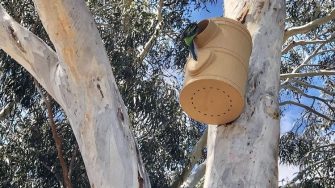- UNSW
- ...
- Our schools
- Biological, Earth & Environmental Sciences
- Student life & resources
- Honours
- Honours projects
- Animal ecology & evolution
- Supplemental habitat for hollow-dwelling animals in our urban setting

Synopsis
Over 300 species of native Australian wildlife use tree hollows for breeding and shelter. Tree hollows are only found in large, old (~100 years) trees, yet these trees are increasingly removed for human development or for safety reasons. The NSW state has listed the loss of hollow-bearing trees as a key threatening process for the ecosystem given their importance for our wildlife.
We need supplemental habitat for our wildlife to use. Wildlife managers and scientists have trialled many types of nestboxes and artificial hollows, leading to the development of increasingly sophisticated habitat options. But do the new artificial hollows work?
Aims
This study will determine whether supplemental nestboxes and constructed hollows successfully recruit target wildlife such as parrots and possums in our local urban setting. Working with LGAs in the eastern suburbs, the student will assist with a research trial of these new technologies to assess their suitability as a habitat replacement.
Student benefits
- Gain skills in using wildlife camera traps and extract data from the images
- Learn species identification
- Perform on-the-ground animal surveys
- Integrate with local governments
- Gain experience and skills in project management, data analysis & interpretation, and communication
Supervisor: A/Prof. Lisa Schwanz
Get involved
To learn more about this project, contact A/Prof. Lisa Schwanz
E: l.schwanz@unsw.edu.au, opens in a new window
T: +61 2 9385 0034
